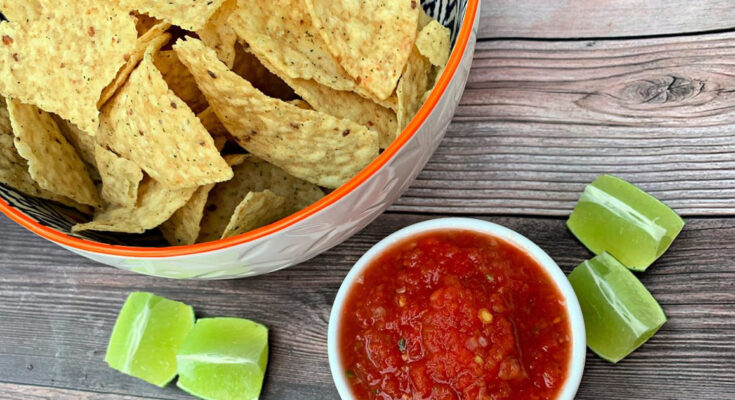Chili’s Salsa Recipe: If you’ve ever been to Chili’s, you already know that one of the stars of the menu isn’t just the burgers, fajitas, or ribs—it’s the irresistible basket of tortilla chips served with their signature salsa. Fresh, tangy, and loaded with flavor, Chili’s salsa has earned a loyal fan base. It’s not just a dip; it’s the kind of appetizer that makes you keep reaching for chip after chip until the bowl is empty.
So, what makes this salsa so special? Unlike many store-bought salsas that are either too sweet or overly processed, Chili’s salsa hits the sweet spot of flavor balance. It’s not overwhelmingly spicy, yet it has just enough kick to keep things interesting. Add in a touch of smokiness from fire-roasted tomatoes, and you have a restaurant-quality salsa you can easily recreate at home.
Making your own Chili’s salsa isn’t complicated—it’s quick, budget-friendly, and perfect for family gatherings, parties, or just your next Netflix night. The best part? Once you try this recipe, you’ll never go back to bottled salsa again. Let’s dive into the details so you can bring the flavors of Chili’s right into your kitchen.
Ingredients You’ll Need
Fresh vs. Canned Ingredients
When it comes to salsa, the debate between fresh and canned ingredients always comes up. Chili’s salsa recipe traditionally uses canned tomatoes because they provide consistency in flavor and texture year-round. Fire-roasted canned tomatoes, in particular, give the salsa its distinct smoky kick.
That said, if you’re making salsa in the middle of summer and have access to ripe, juicy tomatoes, go ahead and use them! Fresh ingredients can add a burst of natural sweetness and brightness that elevates the entire dish. The key is balance—if you’re going fresh, consider roasting your tomatoes and peppers first to capture that depth of flavor you’d otherwise get from canned varieties.
Complete Ingredient List with Measurements
Here’s what you’ll need to make Chili’s salsa at home:
- 1 can (14.5 oz) fire-roasted diced tomatoes
- 1 can (10 oz) diced tomatoes with green chilies (like Rotel)
- 1 medium white onion, roughly chopped
- 2–3 cloves garlic, peeled
- 1–2 fresh jalapeños, chopped (remove seeds for less heat)
- ½ cup fresh cilantro leaves
- Juice of 1 fresh lime
- ½ teaspoon sugar (optional, balances acidity)
- ½ teaspoon salt (adjust to taste)
- ¼ teaspoon ground cumin
This list combines both pantry staples and fresh produce, giving you that signature Chili’s flavor. If you prefer extra spice, consider adding a serrano pepper or a pinch of crushed red pepper flakes.
Essential Kitchen Tools for Salsa Preparation
Blenders and Food Processors
The real secret to Chili’s salsa texture is using a blender or food processor. Unlike chunky pico de gallo, this salsa is smooth yet slightly textured, which makes it perfect for dipping. A high-powered blender will give you a creamier consistency, while a food processor will leave it a bit chunkier.
For the best results, pulse instead of blending continuously. This way, you maintain some texture and avoid turning the salsa into tomato soup.
Knives, Cutting Boards, and Mixing Bowls
Even though most of the work is done by the blender, you’ll still need a sharp knife and sturdy cutting board to prep your onions, jalapeños, and cilantro. A mixing bowl will come in handy if you’re adjusting the seasoning after blending.
If you love making salsa often, investing in a good citrus juicer can also be a game-changer. Fresh lime juice makes all the difference compared to bottled versions.
Step-by-Step Guide to Making Chili’s Salsa
Step 1 – Preparing the Vegetables
Start by roughly chopping the onion, garlic, jalapeños, and cilantro. Since everything will be blended later, you don’t need perfect cuts—just make sure the pieces are small enough for your blender or processor to handle. If you want milder salsa, remove the seeds and membranes from the jalapeños. For a fiery kick, leave them in.
This prep stage might feel simple, but it’s essential for balancing the final flavors. Properly prepped ingredients ensure even blending and a consistent taste in every scoop.
Step 2 – Blending to the Perfect Consistency
Once your ingredients are prepped, it’s time to bring them together. Add the fire-roasted tomatoes, diced tomatoes with green chilies, chopped onion, garlic, jalapeños, cilantro, lime juice, sugar, salt, and cumin into your blender or food processor.
Pulse the mixture several times until it reaches the consistency you want. Chili’s salsa is known for being smooth but not watery—it should coat a chip without dripping excessively. The pulsing method allows you to control texture. If you blend too long, it’ll turn soupy; if you blend too little, you might end up with chunky pico de gallo.
The beauty of making this at home is that you can customize it. If you like thicker salsa, pulse less. If you prefer it silky smooth, go for a few more spins. Either way, the aroma of fresh lime and roasted tomatoes will fill your kitchen, making it nearly impossible not to sneak a taste.
Step 3 – Adjusting the Seasonings
After blending, taste your salsa and adjust the seasonings. This is where you transform it from good to great. Maybe it needs more salt for balance, another squeeze of lime for brightness, or an extra jalapeño if you’re craving more heat.
Think of salsa as a living recipe—it’s never “one size fits all.” Your tomatoes might be sweeter one day and tangier the next, so don’t be afraid to tweak. Adding a pinch of sugar can help cut through acidity if needed. On the other hand, a dash more cumin can deepen the flavor, giving it that signature Tex-Mex warmth.
Pro tip: taste with a tortilla chip instead of a spoon. Since you’ll most likely be eating it with chips, this helps you gauge the seasoning more accurately.
Step 4 – Letting the Salsa Rest
This is the step most people skip, but it’s crucial. Once your salsa is blended and seasoned, transfer it to a bowl and let it chill in the refrigerator for at least one hour before serving. Why? Because resting allows the flavors to mingle and deepen. The lime juice infuses, the cilantro blooms, and the spices settle into harmony.
It’s a lot like marinating meat—time transforms the flavor. If you serve it right away, it will still taste good, but after resting, it tastes restaurant-quality.
If you’re preparing salsa for a party or gathering, make it a few hours ahead or even the night before. That way, by the time your guests arrive, it’s bursting with the authentic Chili’s flavor you’re aiming for.
Tips for Perfect Chili’s Salsa Every Time
Balancing Heat and Flavor
Heat is one of the trickiest parts of salsa-making. Too little spice, and it tastes flat; too much, and your guests might be running for a glass of milk. The trick is finding balance. Start with one jalapeño, taste, and add more if needed. Remember that peppers vary in spiciness, so one batch might be hotter than another even with the same amount.
You can also mix up your peppers. Serranos add sharp heat, while poblanos contribute a milder, smoky flavor. If you’re spice-sensitive, stick to jalapeños with seeds removed.
Storage Tips to Keep Salsa Fresh
Homemade salsa doesn’t have the preservatives of store-bought versions, so proper storage is key. Keep your salsa in an airtight container in the refrigerator, and it will stay fresh for 5–7 days. Always stir before serving, as natural separation may occur.
If you want to keep it longer, you can freeze salsa. Just be aware that the texture might change slightly once thawed—it may become a bit more watery. To fix this, simply drain excess liquid or pulse it again in the blender to refresh the texture.
Variations of Chili’s Salsa Recipe
Spicy Salsa Version
If you’re someone who believes salsa should come with a warning label, then the spicy version is for you. To amp up the heat, add extra jalapeños, a serrano pepper, or even a habanero if you’re feeling adventurous. Roasting the peppers beforehand can intensify the heat while also adding a smoky depth.
A splash of hot sauce can also do wonders if you want a quick heat boost. Just remember: it’s easier to add spice than to take it away, so start small and build up.
Smoky Salsa Variation
For a smoky twist, use exclusively fire-roasted tomatoes and roast your jalapeños before blending. You can also add a dash of smoked paprika or chipotle powder for an extra layer of smokiness. This version pairs beautifully with grilled meats, tacos, or even as a topping for burgers.
Chunky Restaurant-Style Salsa
If you prefer a salsa that’s more like pico de gallo, pulse the mixture less and add in some freshly diced tomatoes and onions after blending. This gives you the freshness of raw veggies with the depth of blended salsa. It’s hearty, chunky, and perfect when you want something closer to a homemade vibe.
Serving Suggestions for Chili’s Salsa
Pairing with Chips
There’s no denying that tortilla chips and salsa are a match made in heaven. At Chili’s, you get bottomless chips for a reason—because that salsa is dangerously addictive. When serving your homemade version, opt for thin, crispy tortilla chips. The lightness of the chip allows the salsa flavor to shine through, while still holding enough strength to scoop without breaking.
If you want to go the extra mile, make your own tortilla chips at home. Simply cut corn tortillas into triangles, lightly brush them with oil, sprinkle with salt, and bake until golden and crunchy. Homemade chips not only elevate the experience but also pair beautifully with the freshness of homemade salsa.
For a party setting, serve your salsa in a wide, shallow bowl to encourage dipping. Garnish with a little extra cilantro or diced jalapeños on top to give it a restaurant-style presentation.
Salsa as a Topping for Meals
Salsa isn’t just a dip—it’s also a versatile topping that can bring life to many dishes. Use it as a zesty topping for tacos, enchiladas, burritos, or nachos. A spoonful of salsa over scrambled eggs or an omelet turns a simple breakfast into a Tex-Mex treat.
It also works as a flavor booster for grilled chicken, fish, or steak. Instead of a heavy sauce, salsa adds a refreshing brightness that complements smoky, savory flavors. You can even mix it into cooked rice or beans for an instant flavor upgrade.
So next time you whip up a batch of Chili’s salsa, don’t limit yourself to chips. Think of it as a multipurpose condiment that can transform your meals in seconds.
Common Mistakes to Avoid When Making Salsa
Over-Blending the Mixture
One of the biggest mistakes beginners make is over-blending the salsa. It might seem harmless to let the blender run, but too much blending destroys the texture and leaves you with a thin, soupy sauce. Chili’s salsa is smooth but still has body—it’s not meant to pour like tomato juice.
To avoid this, use the pulse function on your blender or food processor. Pulse just enough to combine the ingredients while keeping small bits of onion, cilantro, and jalapeño intact. This way, you get both smoothness and texture in each bite.
Using Too Much Salt
Salt is a flavor enhancer, but too much of it can ruin your salsa. Since tortilla chips are already salted, the salsa doesn’t need to be overly seasoned. Always start with less salt, taste with a chip, and adjust from there.
Another common mistake is forgetting that salsa flavors intensify as it rests in the fridge. What tastes perfectly balanced when fresh might taste saltier after an hour. That’s why it’s safer to season lightly at first and make small adjustments later.
Avoiding these mistakes ensures your salsa comes out just as addictive as the one served at Chili’s—balanced, flavorful, and impossible to stop eating.
Health Benefits of Homemade Salsa
Nutritional Value of Tomatoes and Peppers
Homemade salsa isn’t just delicious—it’s also packed with nutrients. Tomatoes are rich in vitamin C, potassium, and lycopene, a powerful antioxidant linked to heart health and reduced cancer risk. Peppers, whether mild or spicy, bring an extra boost of vitamins A and C, along with capsaicin, a compound known for its metabolism-boosting properties.
Onions and garlic also play a role in salsa’s health benefits. They contain compounds that support heart health, reduce inflammation, and even boost immunity. Cilantro adds a fresh dose of antioxidants while also aiding digestion.
Low-Calorie, Flavor-Packed Snack
One of the best things about salsa is that it’s naturally low in calories. Unlike creamy dips made with sour cream or cheese, salsa provides bold flavor without the guilt. A few scoops with baked tortilla chips or veggie sticks make for a snack that’s satisfying but still light.
It’s also a great way to sneak more vegetables into your diet. Whether you’re dipping, topping, or mixing it into meals, salsa adds nutrients without extra fat or sugar. If you’re watching your weight or simply trying to eat healthier, salsa is one of the best condiments you can keep in your fridge.
FAQs about Chili’s Salsa Recipe
Can I Freeze Homemade Salsa?
Yes, you can freeze salsa, but the texture may change slightly once thawed. To minimize this, drain any excess liquid before freezing and store in airtight containers. When ready to use, thaw in the fridge and give it a quick stir or blend before serving.
How Long Does Salsa Last in the Fridge?
Homemade salsa stays fresh for about 5–7 days in the refrigerator when stored in an airtight container. If it starts smelling sour or looks watery, it’s best to discard it.
Can I Use Fresh Tomatoes Instead of Canned?
Absolutely! Fresh tomatoes give salsa a bright, summery flavor. For best results, roast or grill them first to add depth and reduce excess wateriness.
How Do I Make My Salsa Less Spicy?
If your salsa turns out hotter than expected, balance it by adding more tomatoes or a touch of sugar. Removing the seeds and membranes from peppers before blending also helps reduce heat.
Is This Salsa Gluten-Free and Vegan?
Yes! Chili’s salsa recipe is naturally gluten-free and vegan, making it a versatile snack everyone can enjoy.
Conclusion
Recreating Chili’s salsa at home is easier than you think—and the results are worth every bite. With just a handful of ingredients, a blender, and a little patience, you can enjoy a restaurant-quality dip that’s fresh, flavorful, and endlessly versatile. Whether you pair it with crispy tortilla chips, spoon it over tacos, or use it as a healthy snack, this salsa will quickly become a staple in your kitchen.
The best part? Once you master the basics, you can experiment with variations—spicier, smokier, chunkier—the possibilities are endless. So next time you crave Chili’s famous salsa, skip the takeout and whip up your own batch right at home.



